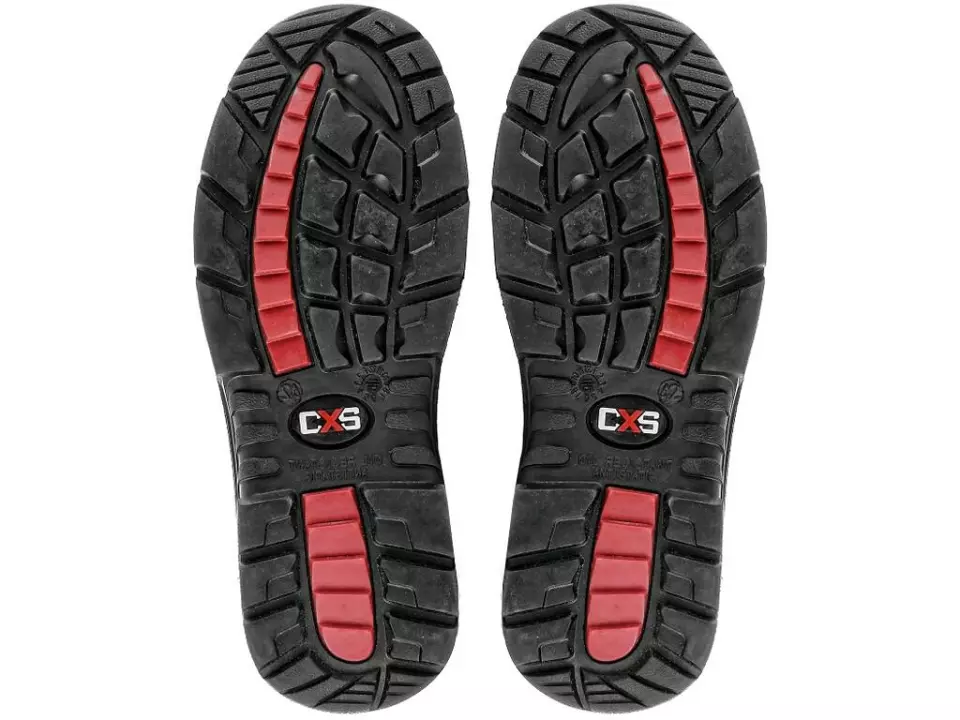CXS Drago Work Ankle Footwear S1
CXS
visit storeProduct description
Product Features:
- Ankle footwear
- Quality thick embossed leather upper
- Steel toe cap
- Covered flexible rubber spring
- PU-rubber construction
- Antistatic properties
- Oil-resistant
- Anti-slip outsole
- Heat resistant up to 300°C
Technical Details:
- Material: Leather with covered spring
Indicates the exterior color of safety footwear, helping you match workplace dress codes while considering visibility and practicality in your work environment.
The color of the shoe's bottom surface that affects visibility in low-light conditions, complements uniform requirements, and reflects personal style preferences.
Identifies the protective material in the toe cap that shields against impacts and compression. Different materials offer varying levels of protection, weight, and comfort.
The material composition of the shoe's bottom portion that determines slip resistance, durability, and protection against workplace hazards like chemicals, heat, or punctures.
Withstands degradation from oil exposure, maintaining sole integrity and extending shoe life. Ensures reliable traction in oily environments.
Enhances stability on slick surfaces, reducing the risk of slips and falls. Designed for reliable grip and secure footing in various work environments.
Reduces impact on feet and joints, lessening fatigue during long hours on hard surfaces. Provides enhanced comfort for demanding work environments.
Indicates the shoe's exterior color, which may align with workplace dress codes, visibility requirements, or practical concerns about dirt visibility.
- Heat & Flame Resistance
- Impact Resistance
- Electrical Protection
- Slip Resistant
Request a free sample
Test first and buy later. Visit any product page to request your free sample.
Standards and labels
Test results
General Requirements CRThe standard EN ISO 20345:2011 encompasses general requirements for safety footwear to ensure they provide adequate protection in various occupational environments. Rating 'CR' signifies that the footwear has a cut resistant upper ensuring enhanced protection. The test method involves assessing the material's resistance to splitting or cracking under certain conditions, which simulates real-world industrial hazards involving sharp objects or surfaces. Practically, this result ensures that the footwear is suitable for environments where there is a risk of materials splitting or getting caught, thereby providing essential safety benefits to the user.
General Requirements HROThe HRO result listed in the standard EN ISO 20345:2011 pertains to the heat resistance of the outsole of safety footwear. This test result confirms that the outsole is capable of withstanding exposure to high temperatures without degrading its physical properties and performance. The test method requires that the outsole of the footwear be exposed to 300°C for a minimum of 60 seconds under specified conditions, during which the outsole should not melt or crack, ensuring that it continues to provide protection against hot environments. Since the HRO classification attests to heat resistance, this feature is particularly important in industries such as metallurgy or construction, where contact with hot surfaces is a common hazard. Understanding this result can assist procurement professionals in sourcing appropriate safety footwear that meets the required durability and performance in high-temperature working conditions.
General Requirements S1The designation S1 under the EN ISO 20345:2011 standard signifies a basic level of safety footwear which includes several important features. Specifically, a footwear labeled as S1 has 200 joules toe cap, fully enclosed heel, anti-static protection, and energy absorption in the heel. The testing method to confirm the S1 classification generally involves specific conditions and apparatus to measure the effectiveness of the footwear under these criteria. For instance, the heel energy absorption is often tested by dropping a weight onto the heel and measuring the force transmitted through the footwear to simulate real-world impacts during usage. Meeting the S1 requirement implies that the footwear can adequately protect users in environments where static electricity, basic impacts, and exposure to fuel-related chemicals are a concern. This tag therefore allows safety managers and procurement professionals to match footwear to known workplace hazards, ensuring a suitable level of protection for employees in varied industrial settings.
CE Marking is a label that shows a product meets certain safety and environmental standards set by the European Union. To get the CE Marking, a company must test and certify their product meets these standards. CE Marking is required for many products sold in the EU, including electronics, machinery, toys and medical devices. It helps ensure that products are safe for consumers and the environment, and allows for easy trade within the EU.
CXS delivery terms
Free delivery when you order more than 150,00 € from CXS
Supplier shipping fee 6,68 €
Brand minimum 50,00 €
43,83 €
Shipping fee is 6,68 € for orders under 150,00 €
Sold in units of one pair
Need larger quantities?
Other products you may like
Recently viewed
Need help?
Get help from our experts
Other products you may like
Similar products you may like
CXS
Delivery time: 6 business days
Orders from 50,00 €
Supplier shipping fee 6,68 €
Free shipping on orders over 150,00 €



Find +150,000 products from hundreds of brands
Autonomous sourcing platform
The most efficient way to source and order supplies for your operations
Sourcing
Ordering
List products you’re looking for and we’ll find the best products and prices for you – all for free.
Need help?
Get help from our experts



